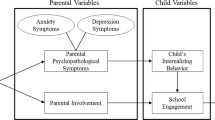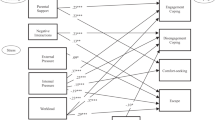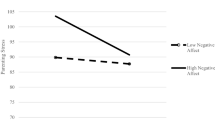Abstract
The purpose of this research was to examine the relationship between parents' perceptions of marital satisfaction and family stress and their third grade children's classroom behavior. Twenty-one married couples completed questionnaires during home visits. Behavior observations were made from videotapes of children recorded in their classroom during lunch and group academic periods on each of three days. Frequencies of peer interactions, solitary behaviors, and teacher interactions were coded. Regression analyses showed that mothers' level of marital satisfaction (but not fathers') predicted their children's frequency of peer interactions during lunch. Fathers' level of perceived family stress (but not mothers') predicted their children's frequency of peer interactions during lunch. Neither measure for either parent was related to the frequency of peer interactions, solitary behaviors, or teacher interactions observed during the academic sessions. These findings highlight the importance of assessing the potential differential relation of parent variables to children's trans-situational behaviors, and the examination of these variables in relation to different social-environmental contexts in which children participate outside the home.
Similar content being viewed by others
References
Brody, G. H., Pellegrini, A. D., & Sigel, I. E. (1986). Marital quality and mother-child and father-child interactions with school-aged children.Developmental Psychology, 22 291–296.
Bronfenbrenner, U. (1974). Developmental research, public policy, and the ecology of childhood.Child Development, 45 1–5.
Bronfenbrenner, U. (1979).The ecology of human development: Experiments by nature and design. Cambridge, MA: Harvard University Press.
Bronfenbrenner, U. (1986). Ecology of the family as a context for human development: Research perspectives.Developmental Psychology, 22 723–742.
Cohen, J. (1960). A coefficient of agreement for nominal scales.Educational and Psychological Measurement, 20 37–46.
Cohen, L. H., Burt, C. E., & Bjork, J. P. (1987). Effects of life events experienced by young adolescents and their parents.Developmental Psychology, 23 583–592.
Cohen, R., & Siegel, A. W. (Eds.). (1991).Context and development. Hillsdale, NJ: Lawrence Erlbaum Associates.
Coie, J. D. (1990). Toward a theory of peer rejection. In S. R. Asher & J. D. Coie (Eds.),Peer rejection in childhood (pp. 365–401). New York: Cambridge University Press.
Compas, B. E., Howell, D. C., Ledoux, N., Phares, V., & Williams, R. A. (1989). Parent and child stress and symptoms: An integrative analysis.Developmental Psychology, 25 550–559.
Dishion, T. J. (1990). The family ecology of boys' peer relations in middle childhood.Child Development, 61 874–892.
Dubrow, E. F., & Tisak, J. (1989). The relation between stressful life events and adjustment in elementary school children: The role of social support and social problem-solving skills.Child Development, 60 1412–1423.
Emery, R. E. (1982). Interparental conflict and the children of discord and divorce.Psychological Bulletin, 92 310–330.
Eron, L. D. (1982). Parent-child interaction, television violence, and aggression of children.American Psychologist, 37 197–211.
Epstein, J. (1983). Longitudinal effects of family-school-person interactions on student outcomes.Research in Sociology of Education and Socialization, 4 101–127.
Fergusson, D. M., Horwood, L. J., Gretton, M. E., & Shannon, F. T. (1985). Family life events, maternal depression, and maternal and teacher descriptions of child behavior.Pediatrics, 75 30–35.
Fleiss, J. L. (1981).Statistical methods for rates and proportions. New York: Wiley.
Forehand, R., Long, N., Brody, G., & Fauber, R. (1986). Home predictors of young adolescents' school behavior and academic performance.Child Development, 57 1528–1533.
Gottman, J. M., & Katz, L. F. (1989). Effects of marital discord on young children's peer interaction and health.Developmental Psychology, 25 373–381.
Griest, D. L., & Wells, K. C. (1983). Behavioral family therapy with conduct disorders in children.Behavior Therapy, 14 37–53.
Grych, J. H., & Fincham, F. D. (1990). Marital conflict and children's adjustment: A cognitive-contextual framework.Psychological Bulletin, 108 267–290.
Hartup, W. W. (1983). Peer relations. In E. M. Hetherington (Ed.), P. H. Mussen (Series Ed.),Handbook of child psychology: Vol. 4. Socialization, personality, and social development (pp. 103–196). New York: Wiley.
Hartup, W. W. (1989). Social relationships and their developmental significance.American Psychologist, 44 120–126.
Henggeler, S. W., & Borduin, C. M. (1990).Family therapy and beyond: A multisystemic approach to treating the behavior problems of children and adolescents. Pacific Grove, CA: Brooks/Cole.
Hoffman, M. L. (1975). Altruistic behavior and the parent-child relationship.Journal of Personality and Social Psychology, 31 937–943.
Holahan, C. J., & Moos, R. H. (1987). Risk, resistance, and psychological distress: A longitudinal analysis with adults and children.Journal of Abnormal Psychology, 96 3–13.
Howes, P., & Markman, H. J. (1989). Marital quality and child functioning: A longitudinal investigation.Child Development, 60 1044–1051.
Jacobson, N. S., & Margolin, G. (1979).Marital therapy: Strategies based on social learning and behavior exchange principles. New York: Brunner/Mazel.
Ladd, G. W., Price, J. M., & Hart, C. H. (1988). Predicting preschoolers' peer status from their playground behavior.Child Development, 59 986–992.
Lightfoot, S. L. (1978).Worlds apart: Relationships between families and school. New York: Basic Books.
Locke, H. J., & Wallace, K. M. (1959). Short martial adjustment and prediction tests: Their reliability and validity.Marriage and Family Living, 21 251–255.
Maccoby, E. E., & Martin, J. A. (1983). Socialization in the context of the family: Parent-child interaction. In E. M. Hetherington (Ed.), P. H. Mussen (Series Ed.),Handbook of child psychology: Vol. 4. Socialization, personality, and social development (pp. 1–101). New York: Wiley.
MacDonald, K. (1987). Parent-child physical play with rejected, neglected, and popular boys.Development Psychology, 23 705–711.
MacDonald, K., & Parke, R. D. (1984). Bridging the gap: Parent-child play interaction and peer interactive competence.Child Development, 55 1265–1277.
McCubbin, H. I., Patterson, J. M. & Wilson, L. (1985). Family inventory of life events and changes. In D. H. Olson, H. I. McCubbin, H. Barnes, A. Larsen, M. Moxen, & M. Wilson (Eds.),Family inventories: Inventories used in a national survey of families across the family life cycle (pp. 82–119). St. Paul, MN: Family Social, University of Minnesota.
Minuchin, P. (1985). Families and individual development: Provocations from the field of family therapy.Child Development, 56 289–302.
Moos, R. (1974).Family environment scales. Palo Alto: Consulting Psychologists Press.
Neter, J., Wasserman, W., & Kutner, M. H. (1983).Applied linear regression models. Homewood, IL: R. D. Irwin.
O'Leary, K. D., & Emery, R. E. (1984). Marital discord and child behavior problems. In M. D. Levine & P Satz (Eds.),Developmental variations and dysfunction (pp. 345–364). New York: Academic Press.
O'Leary, K. D., & Turkewitz, H. (1978). Methodological errors in marital and child treatment research.Journal of Consulting and Clinical Psychology, 46 747–758.
Olson, D. H., McCubbin, H. I., Barnes, H., Larsen, A., Moxen, M., & Wilson, M. (1985).Family inventories. St. Paul, MN: Family Social Science, University of Minnesota.
Parker, J. G., & Asher, S. R. (1987). Peer relations and later personal adjustment: Are low-accepted children at risk?Psychological Bulletin, 102 357–389.
Pettit, G. S., Dodge, K. A., & Brown, M. M. (1988). Early family experience, social problem solving patterns, and children's social competence.Child Development, 59 107–120.
Putallaz, M. (1987). Maternal behavior and children's sociometric status.Child Development, 58 324–340.
Putallaz, M., & Heflin, A. H. (1990). Parent-child interaction. In S. R. Asher & J. D. Coie (Eds.),Peer rejection in childhood (pp. 189–216). New York: Cambridge University Press.
Rodick, J. D., & Henggeler, S. W. (1980). The short-term and long-term amelioration of academic and motivational deficiencies among low-achieving, inner-city adolescents.Child Development, 51 1126–1132.
Roopnarine, J. L., & Adams, G. R. (1987). The interactional teaching patterns of mothers and fathers with their popular, moderately popular, or unpopular children.Journal of Abnormal Child Psychology, 15 125–136.
Thompson, B., & Vaux, A. (1986). The importation, transmission, and moderation of stress in the family system.American Journal of Community Psychology, 14 39–57.
Author information
Authors and Affiliations
Rights and permissions
About this article
Cite this article
Poag, C.K., Cohen, R., Henggeler, S.W. et al. Marital satisfaction and family stress as predictors of classroom behaviors. J Child Fam Stud 1, 287–303 (1992). https://doi.org/10.1007/BF01322071
Issue Date:
DOI: https://doi.org/10.1007/BF01322071




